6 - Valuing Equity Instruments
Share Basics
Ordinary shares: Shareholder rights
Annual meeting (AGM)
Event at which managers and directors answer question from shareholders, and shareholders vote on the election of directors and other proposals
Proxy: an act through which shareholders direct that their shares be voted for them
Amount of shares correlates to voting power
Proxy contest
Preference shares
Preference over ordinary shares in the distribution of dividends or cash during liquidation
Cumulative vs non-cumulative preferred shares
With cumulative preference shares, any unpaid dividends are carried forward
Non-cumulative preference shares, missed dividends do non accumulate, and the firm can pay current dividend payments first to preference and then to ordinary share shareholders
Preference shares: Equity or debt (hybrid shares)
Debt: pay a given rate over a period of time
Equity: company can skip that payment and it will either accumulate or not accumulate, depending on the type of share it is
Stock Prices and Returns
One year investor
Potential cash flows
Dividend
Capital gain (sale of stock)
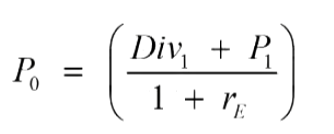
If stock price less than this amount ^, investors will rush in and buy it, driving up the stock price
If stock price exceeds this amount, selling it will cause the stock price to quickly fall
Dividend and Price are uncertain, and rE is an estimate
Dividend yields, Capital Gains and Total Returns
Dividend yield
The percentage return the investor expects to earn from the dividend paid by the share
Div yield = Dividend/price
Capital gain
Capital gain is the difference between the expected sale price and the original purchase price for the share
Capital gains rate
Total return
The sum of the dividend yield and the capital gain rate is called the total return of the share
The total return is the expected return the investor will earn for a one year investment in the share
Dividend yield + Capital Gain Rate = total return
Can manipulate equation to get rE

The price of a share can be found using,
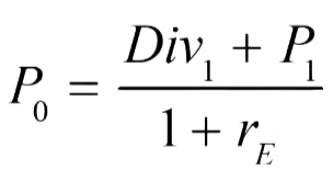
Multi-year investor
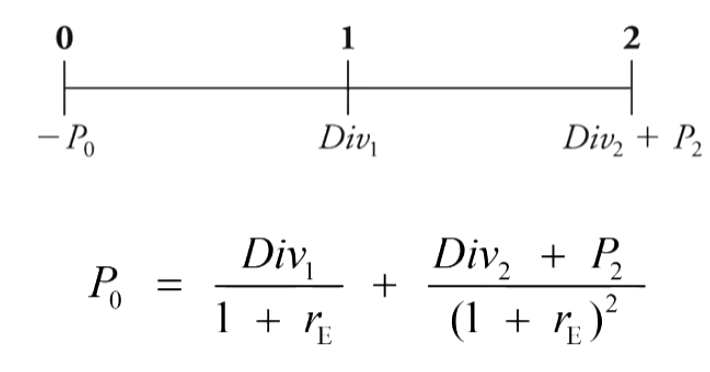
P0 is negative because it is a cash outflow (buying the share)
Div1 is receiving the dividend
Div2 + P2: receive dividend plus the capital gain
All are converted to present values by discounting by estimated rate
Dividend Discount Model

Shows the present value of all the future dividends the company will pay to the shareholder
The price of any stock is equal to the present value of the expected future dividends it will pay
Can generalise this equation (make n very large)
Constant Dividend Growth Model
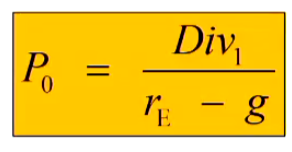
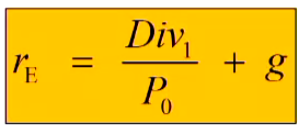
The value of the firm depends on the current dividend level, the cost of equity, and the growth rate
Simplest assumption: the dividend grows at a constant rate
Dividends vs Investment and Growth
Dividend payout ratio: the fraction of earnings aid as dividends each year

Retention rate: fraction of current earnings that the firm retains
Retention rate = 1 - payout ratio
A firm can increase its dividend in three ways,
It can increase its earnings
It can increase its dividend payout rate
It can decrease its number of shares outstanding
A Simple Model of Growth
New investment
Earnings x retention rate
Change in earnings
New investment x Return on New Investment (ROE)
(Earnings x Retention rate) x Return on New Investment
Earnings growth rate (g)
Change in earnings/earnings
(Earnings x Retention rate x Return on New Investment)/Earnings
'g' = Retention rate x Return on New Investment
If dividend payout rate (and hence retention rate) are constant then the growth rate in dividends will equal the growth rate of earnings

Changing growth rates
We cannot use the constant dividend growth model to value a stock if the growth rate is not constant
Young firms often have high initial earnings growth rates. As they mature, their growth slows. Eventually, when their earnings exceeds their investment needs, they begin to pay dividends.
Cannot use the constant growth model when a company's growth isn't steady. But once the growth rate stabilises, we can use the model to estimate the future stock price.
Constant growth dividend discount model

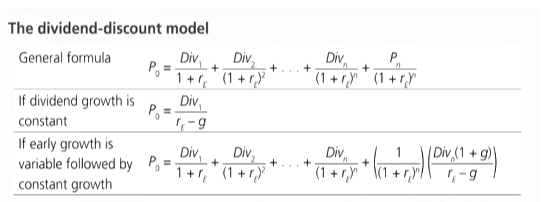
Limitations of the Dividend-discount model
Tremendous amount of uncertainty associated with forecasting a firm's dividend growth rate and future dividends
Small changes in the assumed dividend growth rate can lead to large changes in the estimated stock price
Many companies do not pay dividends for a very long time, thus the dividend-discount model must be modified
Share repurchases
Share repurchases: the firm uses excess cash to buy back its own share.
Consequences,
The more cash used to repurchase shares, the less cash it has to pay out dividends
By repurchasing shares, the firm decreases its share count, which increases its earnings and dividends on a per-share basis
In the dividend-discount model, a share is valued from the perspective of a single shareholder, discounting the dividends the shareholder will receive:

Total Payout Model
Value of all the firm's equity, rather than a single share
Discount total payouts that the firm makes to shareholders, which is the total amount spent on dividends and share repurchases

